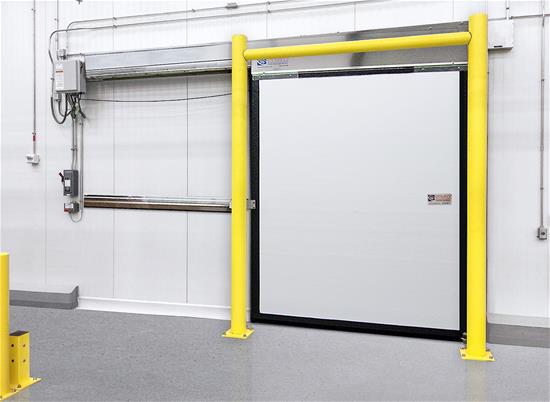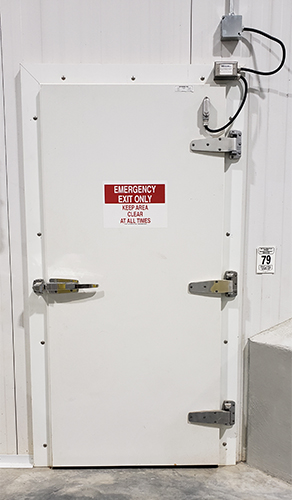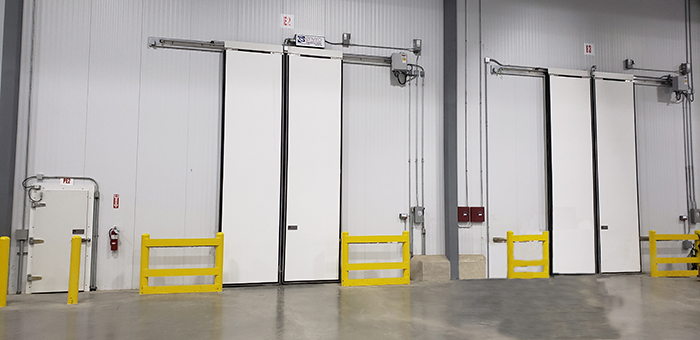Cold storage businesses eat up a lot of energy every year. Cold storage companies spend more than $30 billion on energy every year, and they have the third-highest industrial energy requirements. Many cold storage business owners adopt new technologies for energy efficiency. One solution is to improve energy efficiency in cold storage with cold storage doors.
Cold Storage and Energy Consumption
Practically the entire food supply chain in the US relies on storage technologies. Companies need solutions to cool foodstuffs and maintain food quality as they transport goods from one location to another. Even within homes, many people rely on refrigeration technologies to store and preserve food.
According to data from the Food and Agricultural Organization of the United Nations, the food sector produces nearly 30% of global energy consumption and about 22% of global greenhouse gas emissions. As such, demand for energy consumption from cold chain supply is a major contributor to climate change.
Data indicates that for many companies, refrigeration equipment makes up nearly a tenth of their carbon emissions. Energy usage for refrigeration is extremely high because it requires a significant amount of electrical energy that must be continuously running. Additionally, the rising demand for fossil fuels causes increases in the demand and prices for commodities, such as food.
The connection between the global economy and food/commodity storage has a cascading effect. This reliance on such a system with high energy demand and cost has led companies to search for industrial storage solutions that are more energy-efficient and climate-friendly, such as solar-powered doors and thermally efficient materials.
Why Does Refrigerated Storage Use So Much Electricity?
The average refrigerated warehouse uses approximately 25 kWh of energy per square foot for cooling costs annually. That comes out to an average of over 9,000 BTUs of natural gas per square foot per year—a significant amount of energy costs.
The reason why cold storage facilities use so much electricity on average has to do with basic thermodynamics. The natural process of diffusion causes heat to move from areas of high temperature to areas of low temperature. If turned off, a refrigerator would eventually reach equilibrium with outside temperatures.
Refrigeration technology utilizes electricity and pressure to remove hot air from the inside and keep interior temperatures low. Maintaining a temperature disequilibrium requires a more-or-less constant supply of electrical energy. The need for constant power is one reason why food and refrigeration technology incur such a large global electricity bill.
Cold Storage Facility Doors Can Improve Energy Efficiency
Data showing increased global energy costs have caused numerous companies to invest in technologies for energy efficiency. One extremely effective solution for thermal efficiency is installing new doors on your cooling systems.
Reduce Energy Loss
The main benefit of installing new doors on your equipment is that they can significantly reduce energy loss from thermal radiation. The degree of thermal radiation a body permits is measured by its R-value. Doors with high-R-values are better insulators and lose less energy from thermal loss.
Old doors made from iron or steel have relatively low R-values and can allow for radiation, requiring your cooling system to work harder to maintain a low-temperature surrounding. Modern cold storage facility doors feature efficient insulating materials that reduce energy losses and energy costs.
Operational Efficiency
Cold storage facilities need to open and close to transport goods in and out. Old doors can be slow when opening, leaving more time for air infiltration and thermal transfer.
New doors contain efficiency measures to open and shut much faster, reducing the time that stored goods are exposed to exterior sources of thermal radiation like solar energy. Faster opening and closing speeds also allow for smoother operating conditions, allowing maximum productivity.
Less Air Infiltration
One of the major causes of inefficiency in refrigeration systems is leakage. Old doors with worn-down seals can allow hot air to leak into interior components, causing heating issues. The greater the air infiltration, the harder your refrigeration system equipment must work to maintain proper temperatures.
New, modern doors have durable insulation that keeps air in and makes systems more efficient. Reducing air leaking also reduces the risk of low food quality.
Reliability
Modern refrigeration systems utilize corrosion and puncture-resistant materials that last a long time. Durable coverings ensure long-lasting performance and fewer problems across the product’s lifetime. The more reliable your cold stores’ doors are, the more your facility can keep up with precise shipping schedules and product demand.
Safety
Last but not least, updating your cold store door paneling provides a safe environment for workers. Modern doors contain a wide range of safety features, such as motion sensors, auto-shutoff mechanisms, and breakaway functioning. Safety features protect workers, which can save your business on workers’ compensation and insurance costs.
Lower Maintenance Costs
Refrigerated room maintenance involves inspecting refrigeration equipment and replacing damaged parts. Old doors are more likely to fail, meaning you end up spending more on maintenance costs than you would otherwise.
How Can I Calculate Thermal Loss From Refrigeration Systems?
The main purpose of cold stores is to remove hot air and maintain low temperatures. Heat comes from four primary sources:
- Conduction: Energy that diffuses through ceilings, floors, walls, and external sources (e.g., solar radiation)
- Field: Heating produced as food stores cool to refrigeration temperature.
- Respiration: Produce creates energy from its natural respiration.
- Service Load: Heating from equipment, such as lights, solar sources, motors, doors, and the like.
The total capacity of these thermal sources is the system’s heat diffusion. Energy from service loads accounts for about 10% of total heat. You can calculate the service load heat loss from this data by multiplying total heat capacity by 0.10 to get a rough idea of how much energy savings you can get by switching to new doors. We recommend performing a door analysis and examining the data before purchasing for your next project.
How to Choose Energy Efficient Door Equipment for Cold Storages
If you are not familiar with refrigeration system specifications, it can be difficult to know how to measure door effectiveness. Below are some characteristics to keep in mind when performing cooler or freezer door analysis.
Door Style
Different systems may use distinct door types with different power, space, and hardware requirements. The first part of cold storage equipment analysis is figuring out the right door style for your facility.
The market offers a wide range of door types for cold storage of all sizes, including:
- Hinged Doors
- Sliding Doors
- Service Doors
 Automated Doors
Automated Doors- Specialist Doors
The type of doors you choose depends on your needs. For example, hinged doors are useful for manual operation and foot traffic, while sliding and service doors are better for bulk transportation with equipment like forklifts. The right choice of door can help energy efficiency by ensuring proper control when accessing the cooling chamber.
Temperature Range
The next most important consideration is temperature ranges. Different materials are suited for different temperature ranges. Using a door with improper ranges is bad for energy management and energy savings.
The proper range depends on what kinds of materials and products you work with. For example, pharmaceutical products typically have colder storage requirements than produce.
Environmental Control
Refrigeration technology aims to maintain low temperatures to preserve stored commodities. Proper environmental control is integral to monitoring energy consumption and minimizing energy waste.
Environmental control falls within three major sources of energy loss:
- Convection energy comes from heat transfer between the walls, floors, and seals of the chamber, as well as external sources like solar radiation. Moisture reacts with cold air to form ice crystals in freezer application and form moisture build-up in cooler applications.
- Conduction occurs during energy transfer between materials. Doors that have lower R-values allow for more heat conduction, which negatively affects performance and energy savings. Modern doors utilize materials with high efficiency to minimize power consumption and optimize your system.
- Usage also matters as it determines how often the door will be open and exposed to the environment. You can calculate how many opening cycles you perform each day and choose a door that meets your desired performance.
Before buying a new door, we recommend gathering data about energy consumption and current door performance. Doing so will greatly assist with future system energy management.
Activation
Choosing the right kind of door activation can reduce energy usage and lower the cost of energy. Common activation modes include motion sensors, pushbuttons, pressure sensors, and pulling cords. The right activation solutions can help minimize air infiltration and improve operational efficiency and productivity gains.
Contact ASI Doors Today!
Finding the right storage doors can save on energy costs by making your operation more efficient. Given the negative consequences of excessive energy consumption, energy efficiency in cold storage is in high demand.
If you would like to learn more about energy consumption or efficiency for modern refrigeration or require new cold storage doors for your project, contact us online or give us a call at (800) 558-7068 to request a quote! We look forward to connecting with you!

